If one draws on the poet Charles Baudelaire’s imagination, the promise of the oasis would itself be reason enough for the journey, as an invitation to go elsewhere, to a far better place where our ever more pervasive dissatisfactions, our recurring insatiability would finally find a remedy for appeasing them.

In French, the word “oasis” is feminine, almost motherly, like the term – island – used by the ancient Greeks to designate the oases discovered during their first observations of Africa. The geographer, Herodotus, born in 480 BC, even went so far as to describe the oases of Egypt and Libya as the “islands of the blessed”, thus for ever paving the way for a long litany of qualifiers that will indelibly engrave in us the image of the oasis as the place of unexpected and crucial peace in confronting the violence of life and the world.
For this is the reality: an oasis only exists owing to the harshness of its environment. Besides being an inexhaustible source for any dreams of well-being, an oasis is rather the tangible response, instinctive and reasoned, to the discomfort of existence on Earth.
The oasis is an ecosystem of life in the face of adversity
The oasis is the fruit of the ability of human genius to adapt to conditions imposed by nature and by life. At heart, an oasis is not a gift of nature at all but the pure expression of a collective intention that has led groups of humans to cease their long journeying and to decide to build a community, home and culture, where there had previously been nothing.
Over the centuries, the oasis has become a symbolic place for an affirmation of mankind’s ability to organise its husbandry of life in the face of adversity, amid a scarcity of natural resources and facing all contingencies, all those unforeseen fatalities, all those endlessly threatening dangers.
As a tiny island of salvation, the oasis will function as an ecosystem of life in which there will perpetually be a commingling of human beings, where traditions and arts will develop, where techniques and crafts will be invented, where economies will grow; everything that plays a role in the dynamic emergence of civilisation.
However, this idyllic version of the oasis should not cause us forget all the efforts required to develop it and to make it flourish, nor yet its structural fragility and the incessant effort that its inhabitants had to engage in to maintain the balance between the diverse and opposing forces which both surround it and create it.
The oasis is an art of existing within the world, and on Earth
More than just an achievement, the oasis illustrates humanity balanced at a point where the Earth is staring into the void: a living and active humanity, rich in experience, expertise, and which succeeds in creating harmony within itself and with whatever surrounds it.
In order to maintain stability, this fragile balance will have constantly required human vigilance and rigour, respect for rules, innovation, hard work, collegiality, sharing, solidarity and responsibility.
The oasis, from its origins to the present day, will thus have provided humanity with a formidable training ground in the art of existing within the world and on Earth.
This know-how is precious for human societies in order to better address the challenges of tomorrow, especially since achieving a new balance between Nature and all Living beings is becoming more and more imperative every year.
But today, Morocco’s oases are endangered. They have become the symbol of the dark side of mankind in his propensity to gainsay nature and to tear up the volumes of his own experiences, even though they have been learned at the expense of his own blood and sweat, and throughout the course of such a long journey.
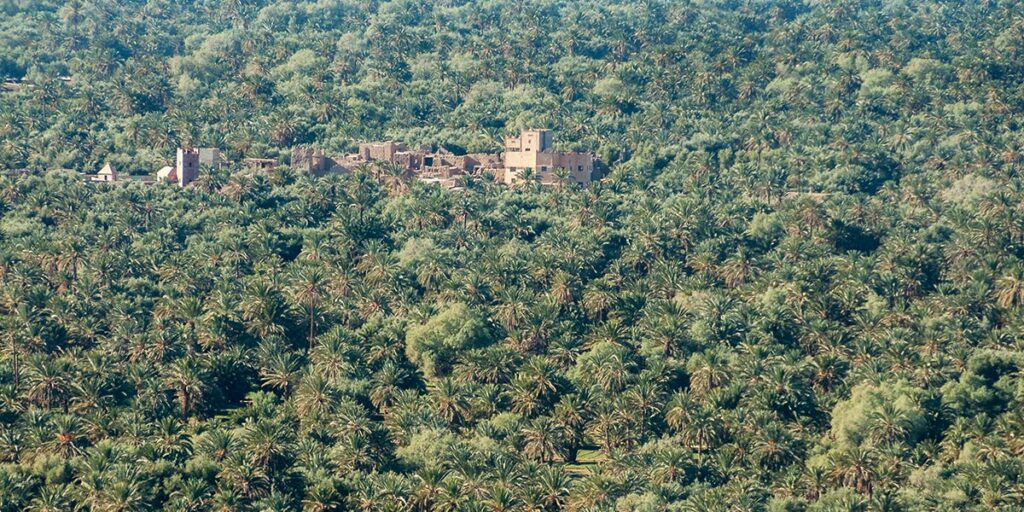
The oasis is a chosen dwelling place
Archaeological research indicates that the first oases emerged in the Arabian Peninsula almost six thousand years ago, at the heart of the Neolithic period. The nascent oasis is the manifestation of a new way of living for the humans of the period, in response to the climate changes causing aridity to spread throughout these once flourishing regions. But this change also appears as an echo to the impulse to settle, which slowly move all the human communities away from their ancestral practices of hunting and gathering, and so too from their traditional seasonal roaming.
The gradual and slow emergence of oases is thus an act of sedentarisation characterised as consisting of developing a specific area chosen according to the presence of arable land and usable water for the benefit of human communal life. Here we clearly observe the etymological meaning of the word oasis, which is directly linked to the Greek term ὄασις, itself taken from Coptic, a Hamito-Semitic language descending from ancient Egyptian, in translation of the word ouahe, signifiying dwelling place.
It required human ingeniousness to channel the surrounding water, surface water from permanent springs or deeper sources from the water table. It was necessary to work the soils by levelling it, removing stones and fertilising it in order to make them operational for the emerging cultures. It is in this area, an Orient bubbling with life, that the technique of capturing spring water was developed through the use of khatarats or foggaras, as they are called in the Maghreb countries, or qanats in ancient Persia. This tremendous technique can be observed in almost all oases of North Africa and, for example, in Morocco in Marrakech, the palm groves of Skoura or those of the now defunct city of Sijilmassa.

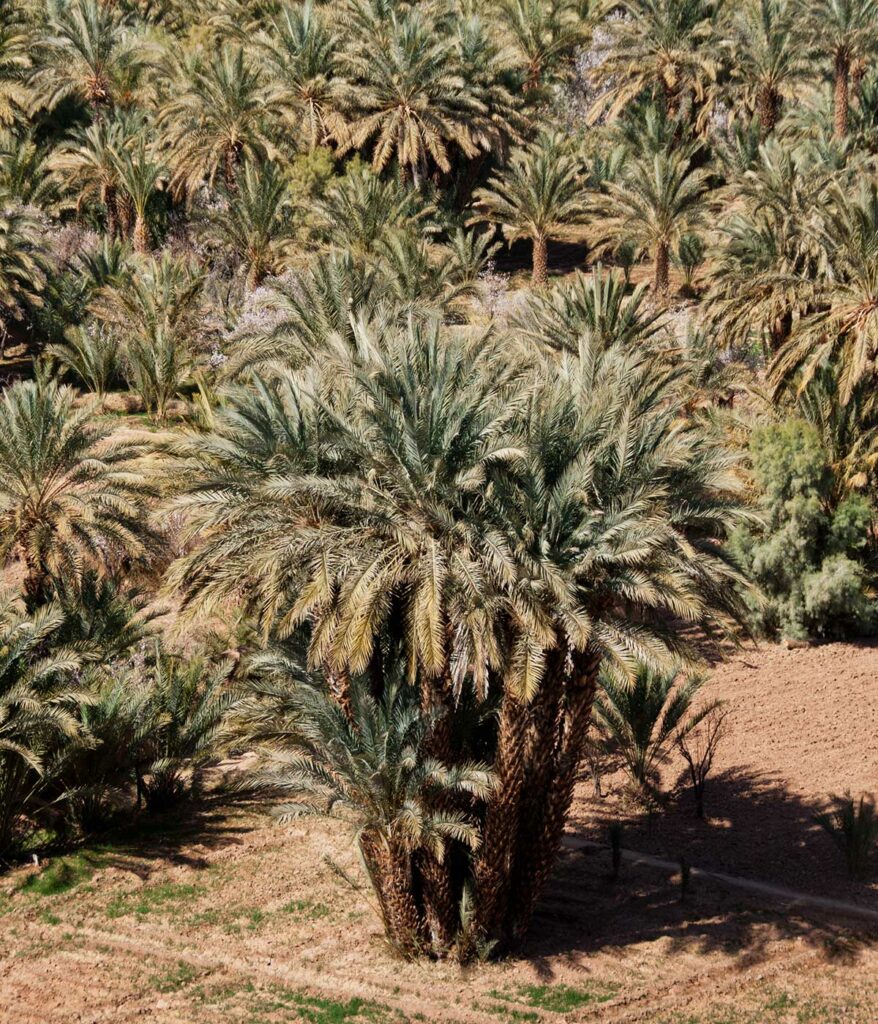
The palm tree, symbol of the oasis, from its birth to its decline
The oasis is also predisposed to be the place where the date palm developed. It has become the emblem of these dwelling places over a large strip of land across the northern Sahara, from the Iranian plateaus to Morocco. As a sustainable source of shade and fertile humus, the palm tree has provided the inhabitants of the oases with a quality foodstuff while allowing for agricultural crops to develop, vertically structured with fruit and olive trees under the broad palmate leaves, and beneath them, vegetables, cereals and fodder for animals.
Léon Lehuraux, a French Camel Corps Officer, writer and ethnologist born in 1885, described the oasis in the following terms:
« The palm tree is a monumental, powerful, royal tree; it shares strength, majesty and perfect elegance; its solitary trunk fills a frame of several leagues and populates a solitude. »
“Le palmier-dattier du Sahara algérien” édité en 1945
Regarded as a symbol of peace and the freshness the oasis offers, the date palm has sadly become the symbol of their decline. In Morocco at the beginning of the 20th century, the various oases of the country contained nearly 15 million palm trees but at the end of the century, only a third remained, most of them having fallen victim to environmental degradation due to climatic variations, pathological diseases, the exodus of their populations and the loss of agricultural know-how.
Today, it is no longer exceptional to come across expanses of dry palm trees. The pomegranate and apple trees that once grew naturally under the shade of their protective elders are disappearing. The mud houses are falling into ruin and are crumbling to dust.
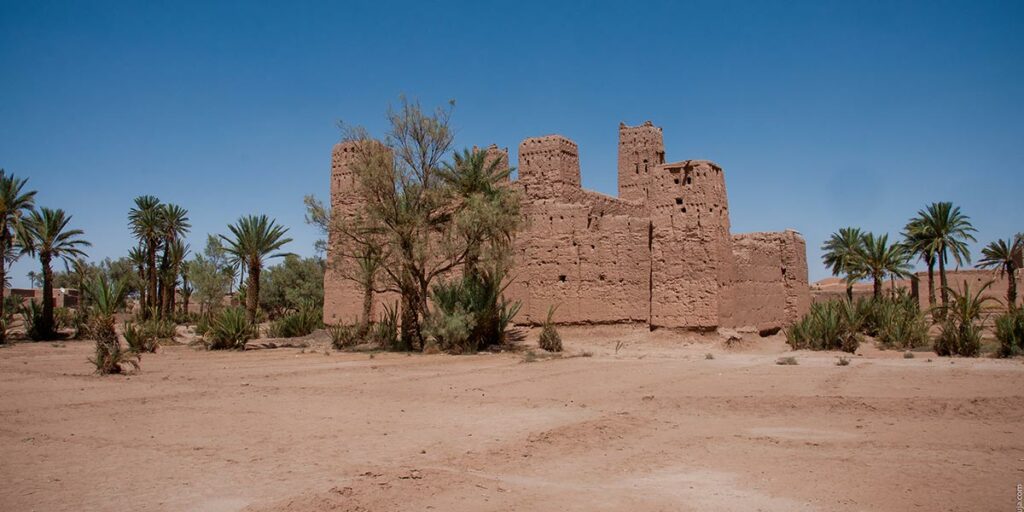
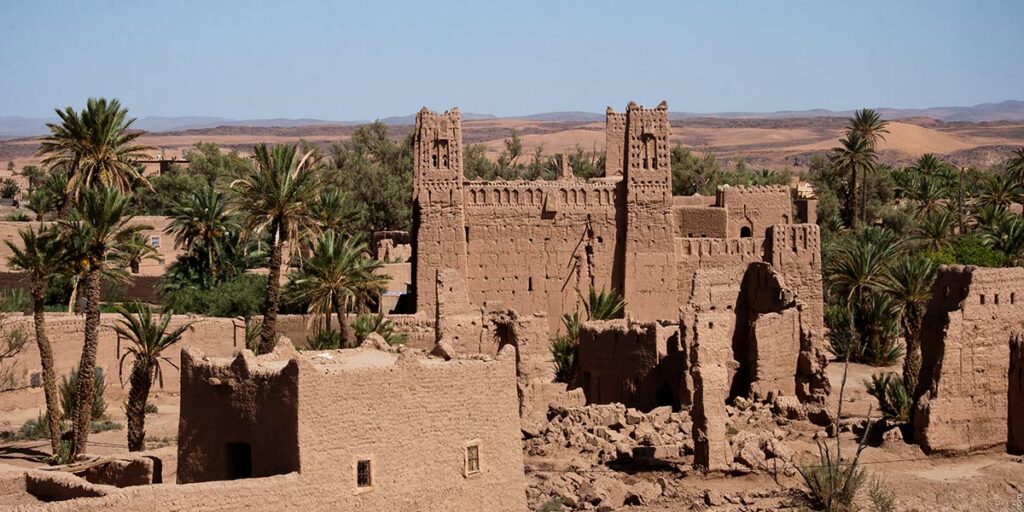
The vanishing civilisation of the oasis
Indeed, here in Morocco as in other countries, the oases are dying, slowly but inescapably, despite the emergence of various ecological perceptions over recent decades.
In 1971 the international community reacted with the implementation of an ambitious scientific programme under the aegis of UNESCO: the Man and Biosphere Programme. In 2000, within this institutional framework, Morocco decided to group its ancestral oases of pre-Saharan territories together under the classification of Biosphere Reserve of the Oases of South Morocco (RBOSM). So this involves nearly 80,000 km2, specifically about 11% of the national territory, including all the upper and middle Draa and Ziz-Gheriss basins in the three provinces of Errachidia, Zagora and Ouarzazate.
In spite of this, in the subsequent nearly twenty years, the decline of the oases continues to be noticeable.
We have to admit that the problems are manifold and that the oases are victims of both endogenous and exogenous scourges. Of course, global warming comes to mind first, since it now renders the traditional ability of oasis communities to manage water scarcity inoperable.
Other important factors have led to the loss of oases, such as the inevitable appeal of urban life and its consumerist philosophies, which have altered the basic needs of the individual. Young people no longer find an existential satisfaction under the shade of palm trees in a rural environment. The country’s dynamic towards modernisation has led to the pre-eminence of a certain agricultural productivity in the oasis territories, in particular with regard to an objective to export, and with the development of monocultures; and all to the detriment of biodiversity and the reasonable use of soil and water resources.
Moreover, all of Moroccan society can be deemed to share the responsibility for abandoning the know-how relating to oasis civilisation. A report published in 2011 by the Royal Institute for Strategic Studies under the direction of Mr. Driss FASSI highlighted this state of affairs:
« Coexistence with the Sahara is centuries old, even a thousand years old since prehistoric times, and has not been contested. But we have gradually fallen into reactionary behaviour, which has not allowed any real development of the new techniques required for the future. »
The oasis system of Morocco: essay on the establishment of a management strategy for the oasis system of Morocco
The distant memory of a collective intelligence
This apathy towards creativity, a human virtue that produced the original feats by the founders of all these oases, has gone hand in hand with the neglect of local governance over these same oases. The oasis has in fact always existed by respecting a balanced management of water resources, a rigorous maintenance of irrigation facilities and all the necessary tending to the palm trees. All of this required the entire human community to maintain a strict adherence to collectively established rules.
Nowadays, and following the slow vanishing of tribal power being replaced by the administrative machinery of the central state, the mobilisation of collective intelligence for oasis management has become a distant memory. The mere multiplication of individual wells, which means the wide use of motor water pumps, has led to a long-standing upheaval in the water balance in these territories.
Finally, the rapid development of tourism has also inevitably disrupted the oasis ecosystem through increased construction, and therefore a greater consumption of water, accompanied by a massive destruction of landscape due to the anarchy of tourist travel routes, especially those that involve motorised vehicles.
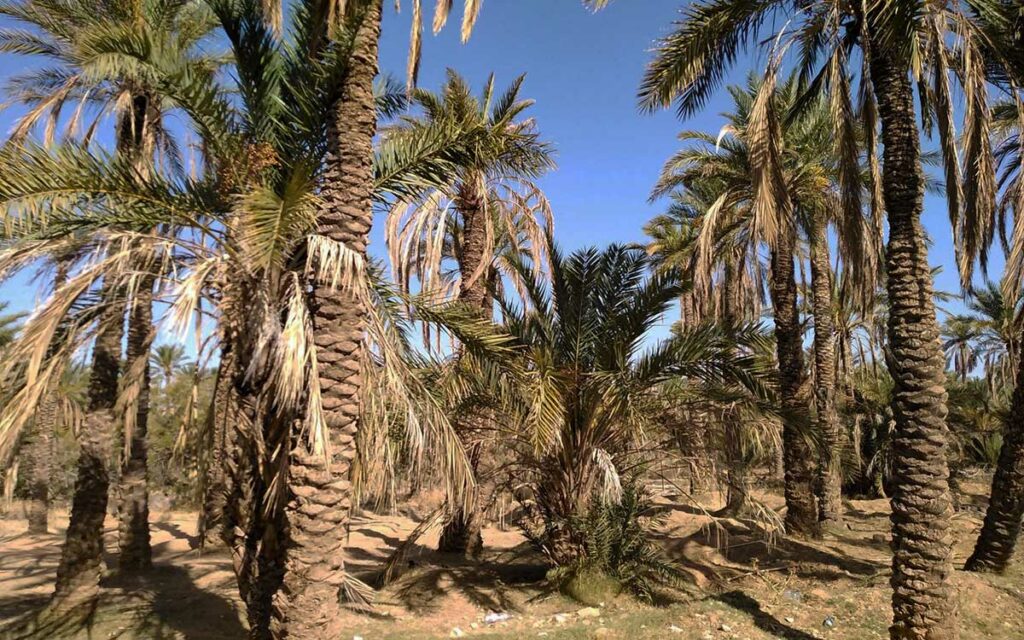
The oasis is the place to transform into a civilisation of sobriety
All the efforts made in Morocco to protect endangered oasis areas will change nothing. The example provided by the National Agency for the Development of Oasis Zones and Argan (Andzoa) is an illustration of this observation. The launch of a major palm tree planting programme in 2008 has certainly led to a revival of the date production and export figures, but this policy of setting target figures does nothing to meet the challenges of knowing how to preserve the oasis.
The proliferation of palm farms in the Drâa Tafilalet region will not be enough to keep the oasis civilisation alive, which has nevertheless chosen the South East of Morocco as the privileged breeding ground.
Any environmental preservation policy that forgets that the oasis, first and foremost, is a place of habitation has necessarily picked the wrong target. And now, more than ever, the oasis must be seen for what it is: the harmonious co-existence between Nature and Man with the intention of communal living and sustainability.
The oasis must be recognized as the memory of eco-compatible lifestyles and at the same time the laboratory of their evolution. The oasis must assert itself as the place for becoming a civilisation of sobriety against one of abundance and waste. The oasis must return to what it has always been; a place of human conviviality, one of welcome, as a meeting point and for interchange.
This is what the oasis in Morocco is all about: the legacy of individual and collective virtues, that more than ever need to be rediscovered and implemented in face of the profound upheavals in human society, and the changes gradually being imposed on our way of life.
Once again, the oasis bears the seed of the promise of a world where life can be good. Once again, it is incumbent on humans to plant this same seed in the soil, and to let it grow.
Photo credits : Abdellah Azizi / azifoto.com
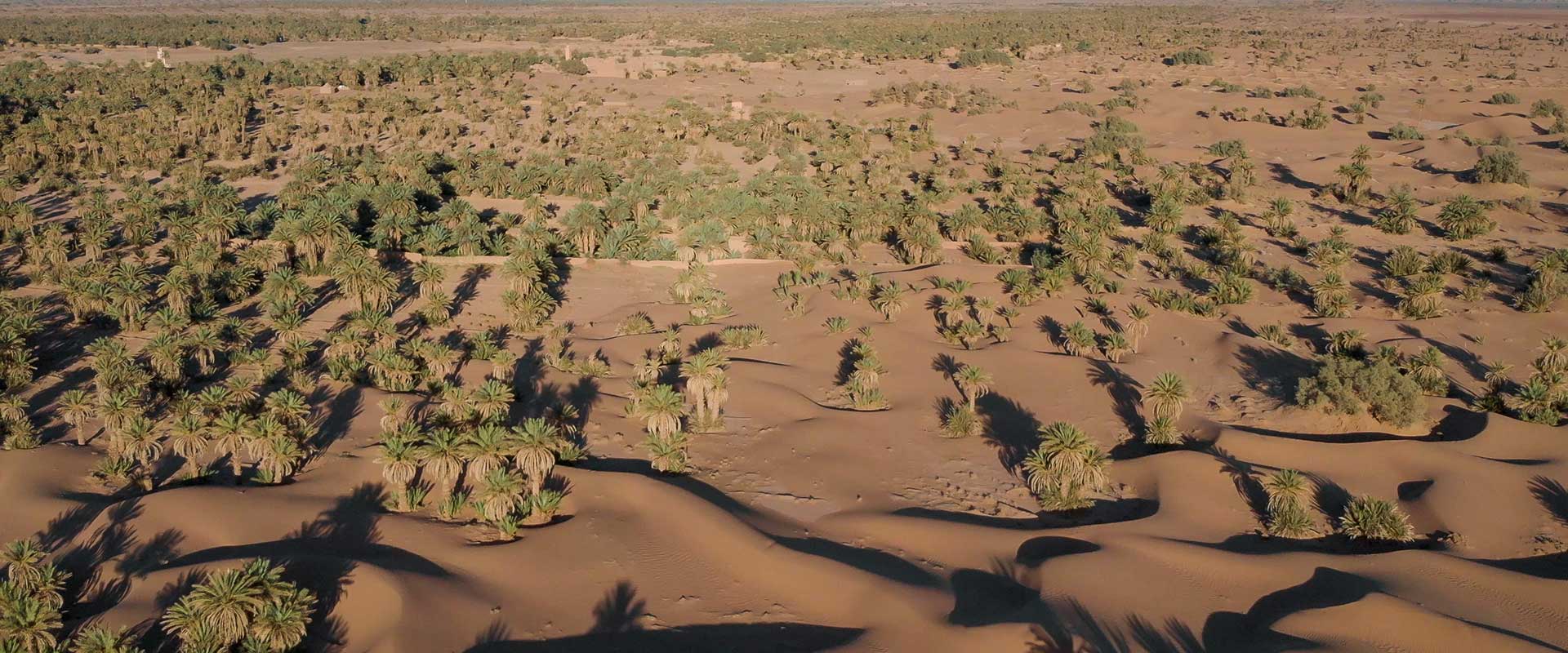


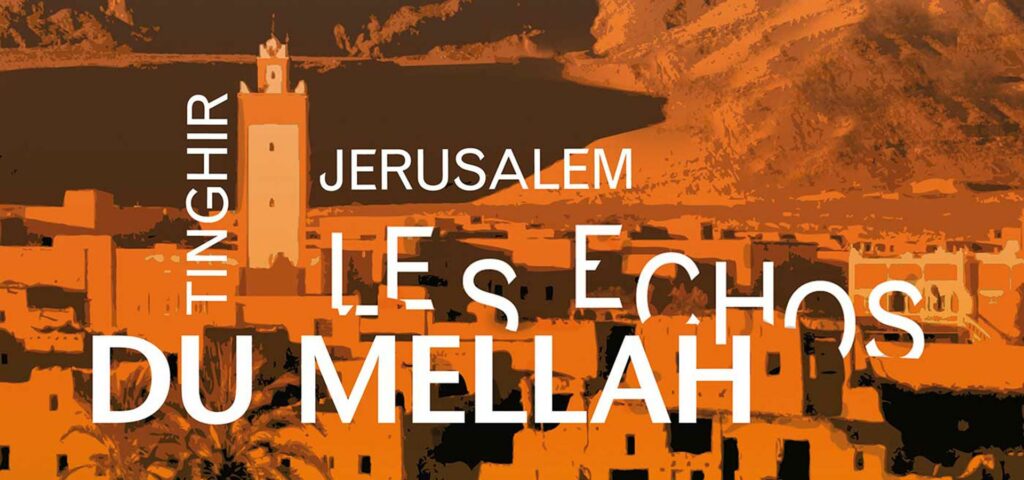
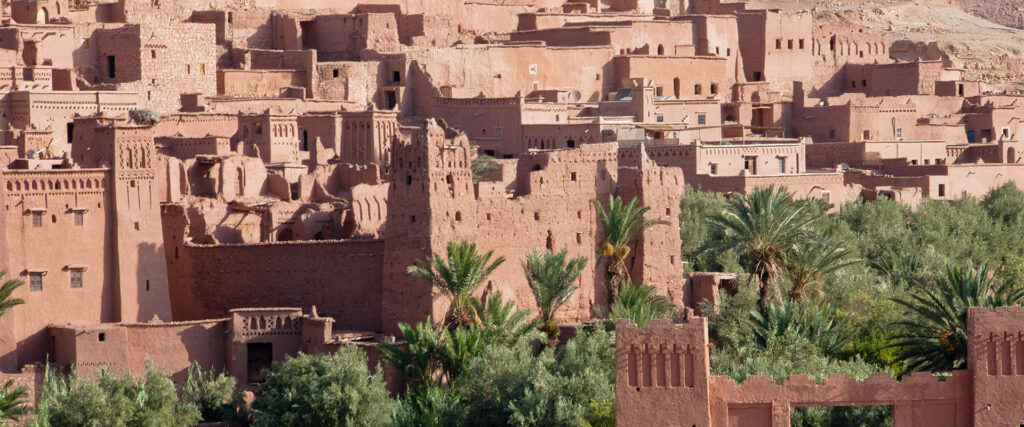
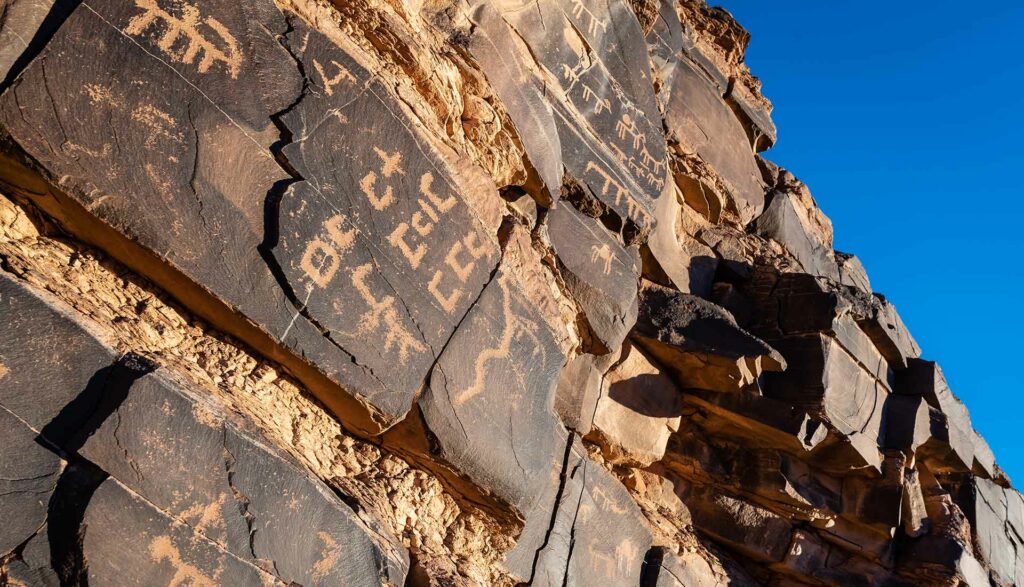
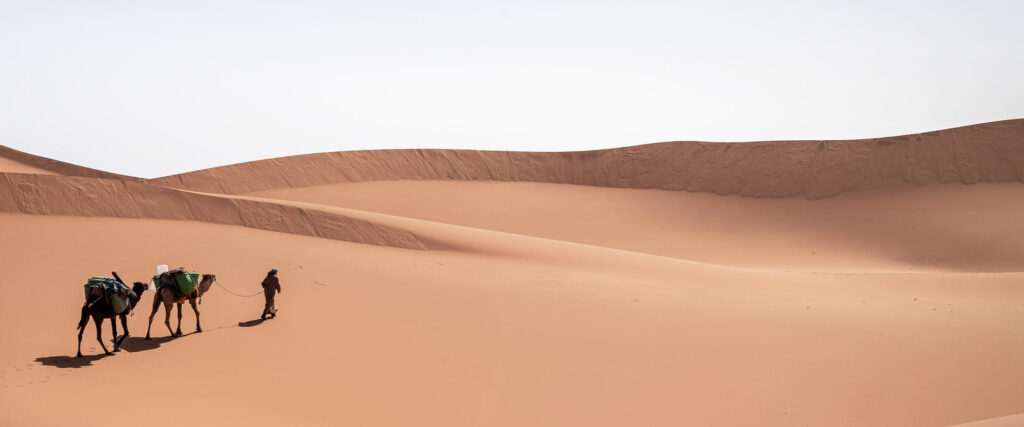

2 Responses
A remarkable article full of knowledge and precise analysis !
“L’oasis est un écosytème de vie au milieu de l’adversité” tout est résumé dans ces mots … Article riche et très intéressant.